The Manhattan Drink Ratio Explained: A Complete Guide
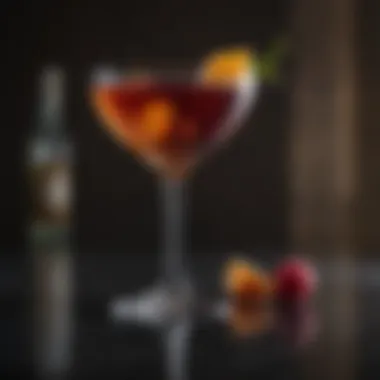
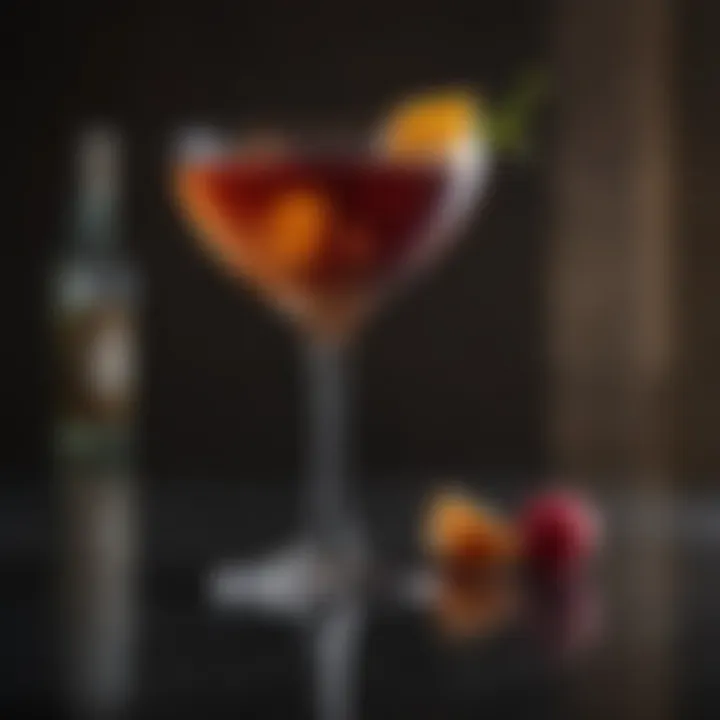
Intro
The Manhattan cocktail stands as a quintessential representation of classic mixology. Renowned for its balanced flavors and sophisticated palate, it has cemented its status in cocktail culture. Understanding the Manhattan drink ratio is not merely an exercise in proportions; it is a gateway to appreciating a drink that has enchanted enthusiasts for generations. This section will set the stage for exploring the ingredients, variations, and nuances that define a truly remarkable Manhattan.
Recipe Overview
Recipe Name
Manhattan Cocktail
Description of the Dish
The Manhattan is a stirred cocktail, typically made with whiskey, sweet vermouth, and bitters. It is served in a chilled cocktail glass, garnished with a maraschino cherry or a twist of orange peel. This drink embodies the essence of balance, with its harmonic interplay between the robustness of the whiskey and the sweetness of the vermouth.
Ingredients
List of Ingredients with Measurements
- 2 ounces rye or bourbon whiskey
- 1 ounce sweet vermouth
- 2 dashes Angostura bitters
- Maraschino cherry or orange peel for garnish
Special Notes on Ingredients
- Whiskey: Rye whiskey offers a spicier profile, while bourbon provides a sweeter, fuller flavor. Choose based on your personal preference.
- Sweet Vermouth: Opt for a high-quality sweet vermouth, such as Carpano Antica Formula or Dolin Rouge, to enhance the drink’s richness.
- Bitters: Angostura is the classic choice, but experimenting with various bitters can introduce unique flavor dimensions.
These ingredients are essential to crafting a traditional Manhattan, yet variations can be made according to taste and availability.
Prelude to the Manhattan Cocktail
The Manhattan cocktail is not just a drink; it embodies a rich narrative steeped in history and significance. Understanding this cocktail extends beyond its recipe; it reveals the transformation of mixology and reflects the culture of its time. The importance of this section lies in establishing a foundational appreciation for the drink itself. Readers will gain insights into how the Manhattan has evolved and its role in shaping cocktail culture today.
Historical Origins
The roots of the Manhattan cocktail date back to the late 19th century. While the exact origins remain somewhat nebulous, the story typically centers on a gathering at the Manhattan Club in New York City. According to legend, a bartender named Ian Marshall created the drink for a banquet hosted by Winston Churchill's mother, rousing intrigue and eventual fame for the cocktail.
The Manhattan quickly gained popularity, appearing in various cocktail guides through the years. Notably, it has been linked to the publication of Jerry Thomas’s "The Bartender's Guide" in 1887. This book marks a significant moment, as it began codifying mixed drinks, solidifying the Manhattan's place in cocktail history.
As American society transitioned through eras of Prohibition and speakeasies, the Manhattan remained resilient, adapting to the preferences of its patrons. It has been a symbol of sophistication and class, often associated with high-profile events and the jazz age. This history provides the context that enriches the experience of enjoying a Manhattan.
Cultural Significance
The cultural significance of the Manhattan cocktail reaches far beyond its taste. It reflects a specific lifestyle and becomes a hallmark of urban sophistication. As Jazz music filled the speakeasies, the Manhattan became the drink of choice among the elite. It represents the craft of cocktail mixing and has influenced countless other drinks.
Moreover, the Manhattan is often seen as a touchstone in discussions about American cocktail culture. Its balance, flavor profile, and adaptability signify a mastery of mixing techniques. By examining the Manhattan, one can appreciate the nuances of quality spirits and how they meld to create a refined taste experience.
The Manhattan's longevity is a testament to its enduring appeal, allowing it to remain relevant in contemporary cocktail culture. In bars worldwide, it serves as a benchmark, often suggesting that if a bartender can master the Manhattan, they can handle the intricacies of mixology. Thus, understanding this cocktail serves as a gateway to deeper exploration into the world of cocktails.
Understanding the Drink Ratio
Understanding the drink ratio is crucial for crafting a Manhattan, as it directly affects the flavor profile and overall experience of the cocktail. The balance of ingredients can enhance or detract from the drink's character. A carefully measured ratio can result in a harmonious blend of sweetness, bitterness, and the base spirit's warmth. This understanding allows mixologists to personalize their cocktails, tailoring them to specific tastes and preferences. Additionally, knowing how to adjust the ratios can lead to discoveries of new flavors and combinations, making the art of cocktail mixing an engaging endeavor.
Defining the Ratio
The drink ratio in a Manhattan traditionally refers to the proportions of whiskey to sweet vermouth. While various formats exist, the classic formula is a 2:1 ratio, meaning two parts whiskey to one part vermouth. This definition serves as a starting point for appreciation and experimentation.
However, ratios can be adjusted based on personal taste preferences and the specific types of whiskey and vermouth being used. For example, a 3:1 ratio may yield a drier drink, emphasizing the whiskey over the herbal notes of sweet vermouth. The choice of whiskey—be it rye, bourbon, or even blended options—will also influence the final taste, underscoring the importance of defining the right ratio.
Importance of Balance
Achieving balance in a Manhattan involves a nuanced understanding of flavors. When all ingredients are in harmony, each sips reveals complex layers. If the whiskey is overly dominant, it can overshadow the subtlety of the vermouth and bitters. Conversely, if the sweet vermouth is too prominent, it might mask the depth of the whiskey.
"Balance in a cocktail is essential for maximizing flavor. Without it, the drink can feel one-dimensional."
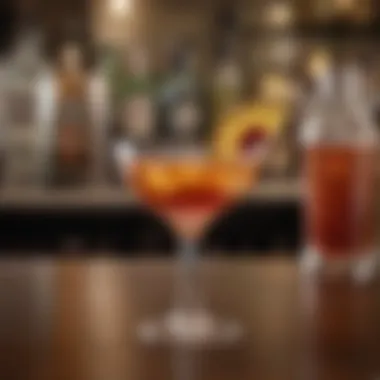
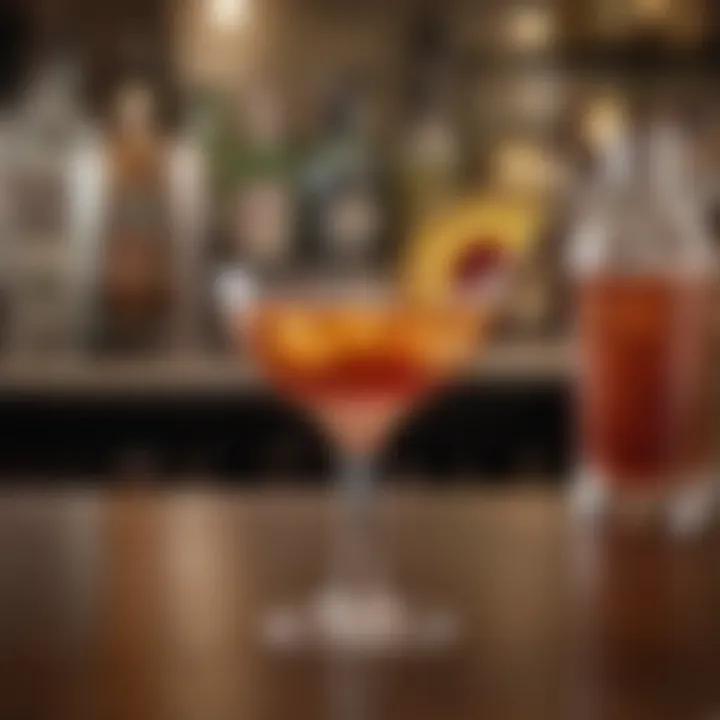
This balance also extends to the bitters; a few dashes can transform the cocktail, providing depth and bitterness that enhance other elements. Thus, understanding and applying the correct ratios and balances is vital for anyone looking to elevate their Manhattan—whether just beginning or refining their skills. Each cocktail embodies a unique interaction of its components, and grasping this interaction allows for more sophisticated and enjoyable drinking experiences.
Core Ingredients of a Manhattan
The core ingredients of a Manhattan cocktail form the foundation of its complex flavor profile. Understanding these elements is crucial to mastering this classic drink. Each ingredient contributes its unique characteristics, helping to achieve the harmony of taste that the Manhattan is known for. Attention to quality and selection of these components will significantly enhance the overall experience of the cocktail.
Base Spirit: Whiskey
Types of Whiskey Used
Whiskey is the cornerstone of a Manhattan, and it is vital to select the appropriate type. The three main categories of whiskey used in the Manhattan are rye, bourbon, and Canadian whiskey. Each type has distinct flavor notes that can significantly affect the final drink.
Rye whiskey is often favored for its spiciness, providing a robust backbone to the cocktail. It typically has a drier finish compared to bourbon. Bourbon offers a sweeter, fuller-bodied profile, which can impart caramel and vanilla flavors. Canadian whiskey tends to be smoother and lighter, making it a milder option.
Selecting the right whiskey depends on personal preferences and desired taste. Using rye can lend a classic flair, as it is the traditional choice, while bourbon caters to those who enjoy sweetness.
Sweet Vermouth
Selection of Vermouth
Sweet vermouth plays a critical role in balancing the drink, as its herbal and sweet characteristics complement the whiskey. There are several brands and varieties of sweet vermouth available. Each has unique flavor profiles, ranging from rich and full-bodied to lighter and more aromatic.
When choosing vermouth, look for one that enhances the overall taste without overpowering the whiskey notes. Popular choices include Carpano Antica, which has a rich, complex flavor, or Dolin Rouge, known for its lighter, floral characteristics.
The choice of vermouth can adjust the perception of sweetness and herbal notes, making it a key consideration in the preparation of a Manhattan.
Bitters
Diversity of Bitters
Bitters might seem like a minor component, but they are essential in creating balance and depth in the Manhattan. The most commonly used bitters is Angostura, known for its unique blend of herbs and spices. Other variations like orange bitters or cherry bitters can introduce additional flavor complexity.
The diversity of bitters allows for creativity in crafting a Manhattan. Each type can subtly alter the drink's overall character, enhancing or contrasting the whiskey and vermouth.
For instance, adding a few dashes of orange bitters can provide a refreshing citrus note, cutting through the richness of the whiskey. Conversely, aromatic bitters emphasize the drink's warmth.
In summary, the core ingredients of a Manhattan—whiskey, sweet vermouth, and bitters—are vital in crafting a cocktail rich in flavor and tradition. Choosing high-quality components leads to a superior drinking experience.
Classic Ratio Formulas
The understanding of classic ratio formulas is fundamental to mastering the Manhattan cocktail. Ratios establish the framework for the drink’s balance and flavor profile. A well-defined ratio can elevate a Manhattan from ordinary to exceptional. Without the knowledge of these ratios, the drink may lack the harmony that characterizes a good cocktail.
Cocktail ratios influence not just flavor but also texture and aroma. Knowing the right balance ensures that no ingredient overpowers another. The amount of whiskey, sweet vermouth, and bitters must align to create the intended experience. This section breaks down the classic approaches to achieving this balance through ratios like the standard 2:1.
The Standard 2: Ratio
The standard 2:1 ratio is perhaps the most recognized formulation for crafting a Manhattan. This means two parts whiskey to one part sweet vermouth. This proportion is widely favored for its straightforward approach to flavor. It allows the whiskey's character to shine while being supported by the smooth sweetness of the vermouth. This ratio is particularly appealing if you prefer a stronger, bolder drink.
In practice, this ratio brings a significant depth to the Manhattan. The requirement is not just to pour but also to consider the specific type of whiskey used. Bourbon, rye, or even Canadian whiskies can bring their own nuances. When each element is in balance, one achieves a cocktail that feels cohesive and satisfying.
Variations: 3: and Others
While the 2:1 is classic, variations exist for those wanting to explore other dimensions of the drink. The 3:1 ratio, which adds one part sweet vermouth to three parts whiskey, is one such option. This creates a drink that emphasizes the whiskey even more, making it ideal for those who want to enjoy the full complexity of the spirit.
Other variations may include adjusting the amount of bitters or substituting different types of vermouth. The ratio can also depend on personal taste or the specific brand being used.
- Consider the following variations:
- 1:1 Ratio: Equal parts of whiskey and vermouth. A very smooth version, softer on the palate.
- 4:1 Ratio: A unique twist for stronger whiskey enthusiasts, focusing heavily on the spirit itself.
Some might even add ingredients like flavored bitters or liqueurs, but it is crucial to keep the essential character of a Manhattan intact. Adjusting ratios can dramatically change the experience, so experimentation is encouraged.
Preparing the Perfect Manhattan
In the realm of cocktail crafting, the preparation of a Manhattan is not merely a step; it is an art form that requires attention to detail. Understanding how to prepare this classic drink allows a mixologist to appreciate the harmony between its ingredients. Emphasizing the right techniques and tools will enhance the overall experience, both in flavor and presentation. This section delves into two crucial aspects: whether to shake or stir and the selection of appropriate glassware.
Shaking vs. Stirring
When it comes to Manhattan cocktails, the choice between shaking and stirring has significant implications for the drink's final taste and texture. Generally, stirring is the preferred method for preparing a Manhattan, especially when using whiskey and sweet vermouth. This technique gently blends the ingredients, maintaining the clarity and silky texture that many cocktail enthusiasts seek.
Shaking, on the other hand, serves a different purpose. It introduces air into the mixture, which can dilute the drink more rapidly due to ice melting faster when agitated. While some may favor shaking for a frothier profile, it is less traditional. Therefore, consider the following elements when choosing your method:
- Content of Ingredients: If using a more delicate vermouth or higher-quality whiskey, opt for stirring to preserve their nuances.
- Personal Preference: Some may prefer the texture that shaking creates. Feel free to experiment.
- Temperature: Both methods can yield a chilled drink, but stirring typically results in a slightly less diluted final product.


"The method you choose can change the drink's character, so understanding the impact is essential."
Glassware Selection
The glassware chosen for serving a Manhattan affects not just aesthetics but also functional elements such as temperature and aroma. Traditionally, a coupe or martini glass is used, which offers a wide surface area. This allows the aroma of the bitters and whiskey to rise, enhancing your drinking experience. Key considerations include:
- Shape: A coupe with its elegant curves or a classic cocktail glass serves the purpose well. Choose based on the impression you want to convey.
- Material: Crystal or glass can improve the feel of the drink. Consider material thickness, as thinner glasses often feel colder and more refined in hand.
- Capacity: Ensure your glass has enough volume to accommodate the drink's volume and any garnish.
Proper glassware contributes to the overall experience, making it integral to preparing a perfect Manhattan. Taking these additional steps enhances your drink, allowing for both visual and sensory enjoyment.
Garnishing the Manhattan
Garnishing the Manhattan is an essential step that transforms a simple cocktail into an elegant experience. The garnish not only enhances the visual appeal of the drink but also plays a crucial role in complementing the flavors. A well-chosen garnish can harmonize or contrast with the underlying components of the Manhattan—whiskey, vermouth, and bitters—elevating the overall tasting experience. Understanding the principles of garnishing will lead to a refined cocktail that impresses both visually and tastefully.
Choosing the Right Garnish
When it comes to a Manhattan, two traditional garnishes stand out: the cherry and the citrus twist. Each option serves a different purpose. The classic maraschino cherry offers a touch of sweetness, which balances the bitterness of the drink. On the other hand, a lemon twist adds a bright, zesty note that invigorates the rich flavors of the whiskey and vermouth.
Here are some things to consider when selecting a garnish:
- Flavor Compatibility: Ensure the garnish complements the cocktail’s flavor profile. A richer Manhattan may benefit from a cherry, while a more herbaceous variation could suit a lemon peel better.
- Quality of Ingredients: Use fresh and high-quality garnishes. A wilted herb or overly processed cherry can detract from the drink’s overall quality.
- Personal Preferences: Understanding your guests' taste can guide your choice. Offering a choice between garnishes can also enhance the cocktail experience.
Presentation Techniques
Presentation is key in cocktail culture. A beautifully garnished Manhattan not only tastes great but also attracts attention. The way a drink is presented can enhance the drinking experience and set the tone for enjoyment.
Consider the following techniques for presenting a Manhattan:
- Glassware: Use a premium coupe or classic martini glass. The choice of glass can elevate the drink’s presentation.
- Garnish Placement: Place the garnish thoughtfully. A cherry can rest at the bottom of the glass, while a lemon twist should be placed along the rim or positioned to release its oils when served.
- Ice Considerations: If served on the rocks, ensure the ice clarity is pristine to create an inviting appearance.
"The first impression of a drink influences its enjoyment. A well-presented Manhattan enhances anticipation and satisfaction."
In summary, garnishing the Manhattan is an art that combines flavor, quality, and presentation. A thoughtful approach to garnishing can significantly elevate this classic cocktail, making it not just a drink but a sophisticated experience.
Personalizing Your Manhattan
Personalizing a Manhattan cocktail is not just about preference; it is a way to engage with the drink and explore one's taste journey. Each individual brings their own palate and sensibilities to the table. When one personalizes their Manhattan, they delve into the nuanced world of flavors, discovering combinations that resonate deeply with their own taste. This aspect is essential, especially in the context of this article, as it allows both novice and experienced mixologists to appreciate the flexibility inherent in this classic cocktail.
Personalization involves various elements, including the ratios of ingredients and the choice of unique components. Experimenting with these factors can lead to unique expressions of the Manhattan, tailored to suit personal preferences. Furthermore, understanding the rationale behind each adjustment can enhance appreciation of the craftsmanship involved in cocktail-making.
When considering personalization, it is vital to take into account the following benefits:
- Flavor Discovery: Tweaking ingredients leads to discovering which flavors work best together.
- Drink Signature: Personalizing allows one to create a signature twist, setting their drink apart.
- Method Mastery: Experimentation improves one's skills in mixing drinks and understanding balance.
This customization fosters creativity, making the cocktail-making process more enjoyable. It engages the drinker on a deeper level, making the Manhattan not only a beverage but a personal statement.
Experimenting with Ratios
Varying the ratios in a Manhattan can drastically alter its profile. The established standard ratio of 2:1, two parts whiskey to one part sweet vermouth, serves as a fine starting point. However, this formula is flexible and lends itself to experimentation.
A common variation is the 3:1 ratio, which favors more vermouth. This results in a sweeter drink with a softer whiskey flavor. For those who prefer a stronger whiskey presence, adjusting the ratio to 4:1 shifts the balance significantly, highlighting the spirit.
When experimenting with ratios, consider the following:
- Base Spirit: Different whiskeys will interact differently with the vermouth and bitters.
- Sweetness Level: Increasing vermouth often results in a sweeter drink.
- Personal Preference: Ultimately, the desired outcome should guide any adjustments.
Each ratio offers a distinct experience, and it is useful to note how small changes can lead to significant differences. Keep a record of the proportions used each time to refine preferences over time.
Exploring Unique Ingredients
Personalization can also come through selecting unique ingredients. The classic Manhattan includes whiskey, sweet vermouth, and bitters, but there are numerous avenues to enhance its complexity. Exploring alternatives, such as different types of whiskey or specialty vermouths, can unearth new flavors.

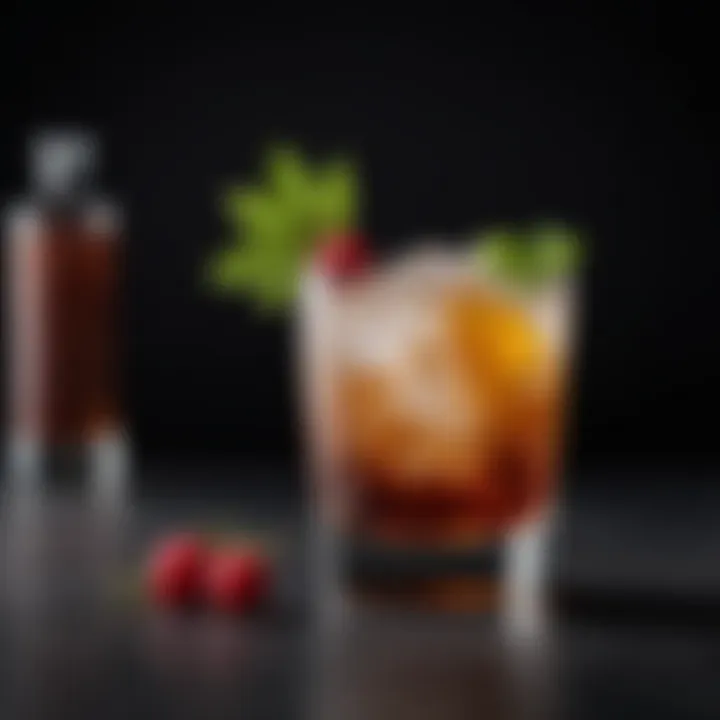
In addition to considering different whiskeys like rye, bourbon, or Canadian whiskey, differently flavored vermouths can add depth. For example, a dry vermouth can invoke a different character, shifting the drink's nature from sweet to a more herbaceous, crisp profile.
Bitters also deserve attention in this context. The traditional Angostura can be replaced or supplemented with aromatic or orange bitters to craft unique dimensions. Experimenting with bitters can result in delightful variations that engage the palate in unexpected ways.
While exploring, keep these tips in mind:
- Research Ingredients: Knowledge about flavor components can guide selection.
- Start Small: Introduce one new element at a time to understand its impact.
- Taste Test: Always taste before serving, ensuring balance and complexity.
By embracing unique ingredients, one can transform a simple Manhattan into a personalized statement, expressing individual taste and creativity in every sip.
Common Mistakes to Avoid
When crafting a Manhattan, precision is key. This section addresses common pitfalls that can compromise the quality of this classic cocktail. Avoiding these mistakes not only enhances the drink’s flavor but also elevates the entire drinking experience. Here are critical elements to consider when mixing your Manhattan.
Improper Ratios
One of the most frequent errors in making a Manhattan is using improper ratios of ingredients. The traditional proportions may vary, yet maintaining a balanced ratio is essential for a harmonious blend of flavors. Many newcomers may deviate from the established standards, such as the classic 2:1 ratio of whiskey to sweet vermouth. This can lead to a drink that is either too strong or too sweet.
Using a 3:1 ratio may sound appealing to some, but it often drowns out the whiskey's character. Such imbalances can be particularly off-putting for discerning palates.
"Finding the right ratio is a subtle art. It can make or break the experience of enjoying a Manhattan."
To avoid improper ratios, consider measuring your ingredients with precision. Using a jigger helps achieve accurate results, ensuring you do not overshoot or undershoot the proportions.
Neglecting Quality Ingredients
Another cardinal mistake is neglecting the quality of the ingredients. Each component in a Manhattan plays a significant role in the drink's overall profile. Opting for inexpensive or low-quality whiskey, vermouth, or bitters can result in a lackluster drink. Quality ingredients offer complex flavors that elevate the simple cocktail into something special.
For example, using a well-crafted bourbon or rye whiskey can significantly enhance the drink. Sweet vermouth should be fresh, and not expired, as it can oxidize. Similarly, the type of bitters used can bring subtle notes that transform the taste. When you prioritize high-quality ingredients, the result is invariably more pleasing.
In summary, do not overlook the impact of your choices in mixing a Manhattan. Thoughtfulness in ratios and ingredient selection is crucial for achieving a well-balanced and enjoyable drink.
The Manhattan in Modern Cocktail Culture
The Manhattan cocktail has secured its place as a classical favorite within the realm of mixology. Its enduring nature speaks volumes about its relevance in today's cocktail culture. We see this classic drink evolving yet maintaining a firm connection to its roots. Understanding this evolution offers valuable insights for enthusiasts and mixologists alike.
Manhattan Variations
One of the standout features of the Manhattan is its adaptability to various tastes and trends. The original formulation serves as a foundation that lends itself to many interpretations. Here are some significant variations:
- Dry Manhattan: Substituting sweet vermouth for dry vermouth shifts the flavor profile towards a crisper taste.
- Perfect Manhattan: This version balances equal parts sweet and dry vermouth. It creates a nuanced flavor that appeals to those who appreciate a more complex cocktail.
- Smoky Manhattan: Incorporating a touch of Islay Scotch whisky brings a smokiness that can transform the drink dramatically. This is for those seeking a bold experience.
- Flavored Variations: Adding fruity or herbal liqueurs can provide unique twists. Ingredients like cherry liqueur or elderflower cordial opens new avenues for experimentation.
These variations reflect the preferences of a new generation of cocktail drinkers, who are keen to experiment while respecting tradition. This kind of creativity enriches the Manhattan’s legacy.
Influence on Other Cocktails
The Manhattan's impact extends far beyond its glass. Many cocktails borrow traits from this classic. Notably, cocktails like the Rob Roy and the Brooklyn are direct descendants. They utilize similar components, altering a few to create entirely new experiences.
The principles governing the Manhattan's construction — the balance of spirit, vermouth, and bitters — have inspired countless other drinks. The ratio-based approach has become a foundational concept in cocktail creation, leading to a renaissance of classic recipes.
In a broader sense, the Manhattan is a symbol of cocktail culture that bridges the past and present. Its influence manifests not just in other cocktails but also in the revival of artisanal and craft cocktail bars. As more bars strive for authenticity, the Manhattan remains a critical reference point for quality and craftsmanship.
"The Manhattan cocktail, with its blend of spirit, vermouth, and bitters, serves as a keystone in both the historical and modern cocktail landscape."
End
In this article, the exploration of the Manhattan drink ratio has unveiled not just its technicalities, but also the significance it carries within cocktail culture. Understanding the balance of ingredients is essential for crafting a Manhattan that honors its legacy while also satisfying contemporary palates. The varying ratios provide endless opportunities for twist and personalization, allowing each mixologist, whether professional or amateur, to create a drink that reflects their taste.
Summarizing Key Points
To encapsulate the key aspects of crafting the perfect Manhattan, it's important to highlight:
- The significance of the primary ingredients: whiskey, sweet vermouth, and bitters.
- The ratios that create different flavor profiles and the classic balance.
- The preparation methods—stirring for clarity and shaking for chill.
- The impact of garnishing choices on presentation and taste.
- The room for personal variation while respecting the drink’s traditions.
Understanding these elements empowers both enthusiasts and professionals to appreciate the complexity of the Manhattan cocktail.
Encouraging Personal Exploration
Experimentation is at the heart of cocktail creation. As discussed, while there are classic formulas, each practitioner can explore various whiskey types, alternates to bitters, and unique garnishes. This freedom allows for a deeper emotional connection to the drink.
For those interested in creating their own signature variant of the Manhattan, consider trying different ratios or ingredients off the classic list. Let personal preferences guide you in adjusting the recipe.
In addition, sharing these unique creations with others fosters a communal spirit that reflects the cocktail’s storied history. In this way, one not only learns about the drink but becomes a part of its ongoing narrative.
Закажите гриль угольный с доставкой по России







